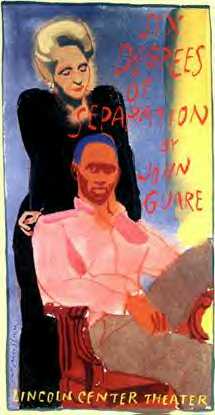 Six degrees of separation is commonly held urban myth that on average everyone on Earth is six connections or less away from any other person. That is, through a chain of friend of a friend (of a friend, etc) relationships you can find yourself linked to the President, the Chinese Premier, a farmer on the steppes of Mongolia, Nelson Mandela, the editor of theDiagonal, and any one of the other 7 billion people on the planet.
Six degrees of separation is commonly held urban myth that on average everyone on Earth is six connections or less away from any other person. That is, through a chain of friend of a friend (of a friend, etc) relationships you can find yourself linked to the President, the Chinese Premier, a farmer on the steppes of Mongolia, Nelson Mandela, the editor of theDiagonal, and any one of the other 7 billion people on the planet.
The recent notion of degrees of separation stems from original research by Michael Gurevich at Massachusetts Institute of Technology on the structure of social networks in his 1961. Subsequently, an Austrian mathematician, Manfred Kochen, proposed in his theory of connectedness for a U.S.-sized population, that “it is practically certain that any two individuals can contact one another by means of at least two intermediaries.” In 1967 psychologist Stanley Milgram and colleagues validated this through his acquaintanceship network experiments on what was then called the Small World Problem. In one example, with 296 volunteers who were asked to send a message by postcard, through friends and then friends of friends, to a specific person living near Boston. Milgram’s work published in Psychology Today showed that people in the United States seemed to be connected by approximately three friendship links, on average. The experiment generated a tremendous amount of publicity, and as a result to this day he is incorrectly attributed with originating the ideas and quantification of interconnectedness and even the statement “six degrees of separation”.
In fact, the statement was originally articulated in 1929 by Hungarian author, Frigyes Karinthy and later popularized by in a play written by John Guare. Karinthy believed that the modern world was ‘shrinking’ due to the accelerating interconnectedness of humans. He hypothesized that any two individuals could be connected through at most five acquaintances. In 1990, playwright John Guare unveiled a play (followed by a movie in 1993) titled “Six Degrees of Separation”. This popularized the notion and enshrined it into popular culture. In the play one of the characters reflects on the idea that any two individuals are connected by at most five others:
I read somewhere that everybody on this planet is separated by only six other people. Six degrees of separation between us and everyone else on this planet. The President of the United States, a gondolier in Venice, just fill in the names. I find it A) extremely comforting that we’re so close, and B) like Chinese water torture that we’re so close because you have to find the right six people to make the right connection… I am bound to everyone on this planet by a trail of six people.
Then in 1994 along came the Kevin Bacon trivia game, “Six Degrees of Kevin Bacon” invented as a play on the original concept. The goal of the game is to link any actor to Kevin Bacon through no more than six connections, where two actors are connected if they have appeared in a movie or commercial together.
Now, in 2011 comes a study of connectedness of Facebook users. Using Facebook’s population of over 700 million users, researchers found that the average number of links from any arbitrarily selected user to another was 4.74; for Facebook users in the U.S., the average number of of links was just 4.37. Facebook posted detailed findings on its site, here.
So, the Small World Problem popularized by Milgram and colleagues is actually becoming smaller as Frigyes Karinthy had originally suggested back in 1929. As a result, you may not be as “far” from the Chinese Premier or Nelson Mandela as you may have previously believed.
[div class=attrib]Image: Six Degrees of Separation Poster by James McMullan. Courtesy of Wikipedia.[end-div]
